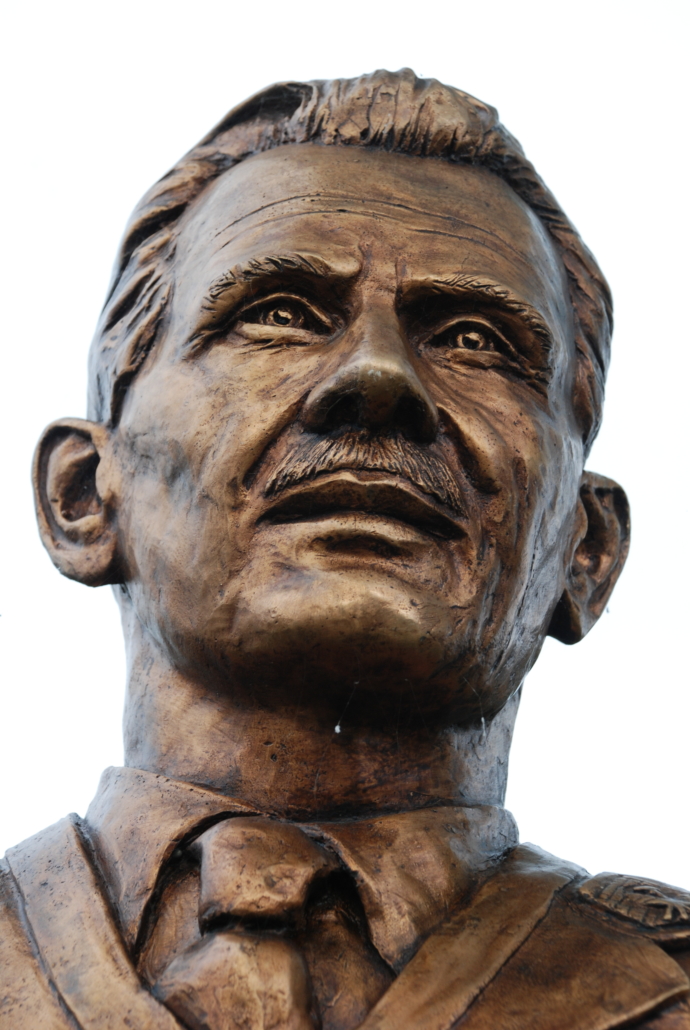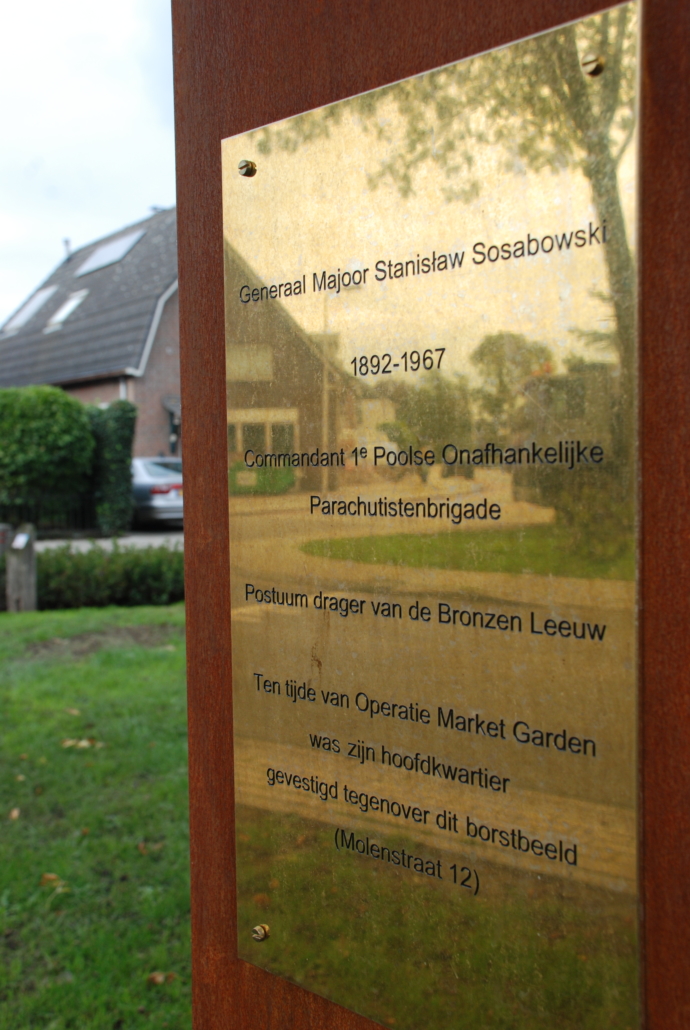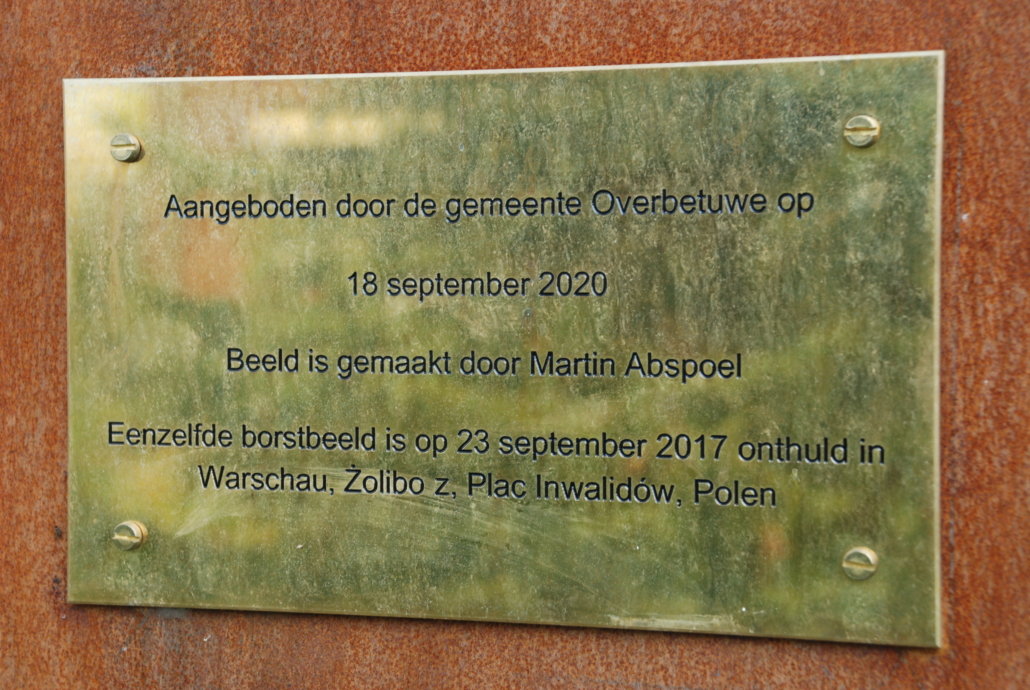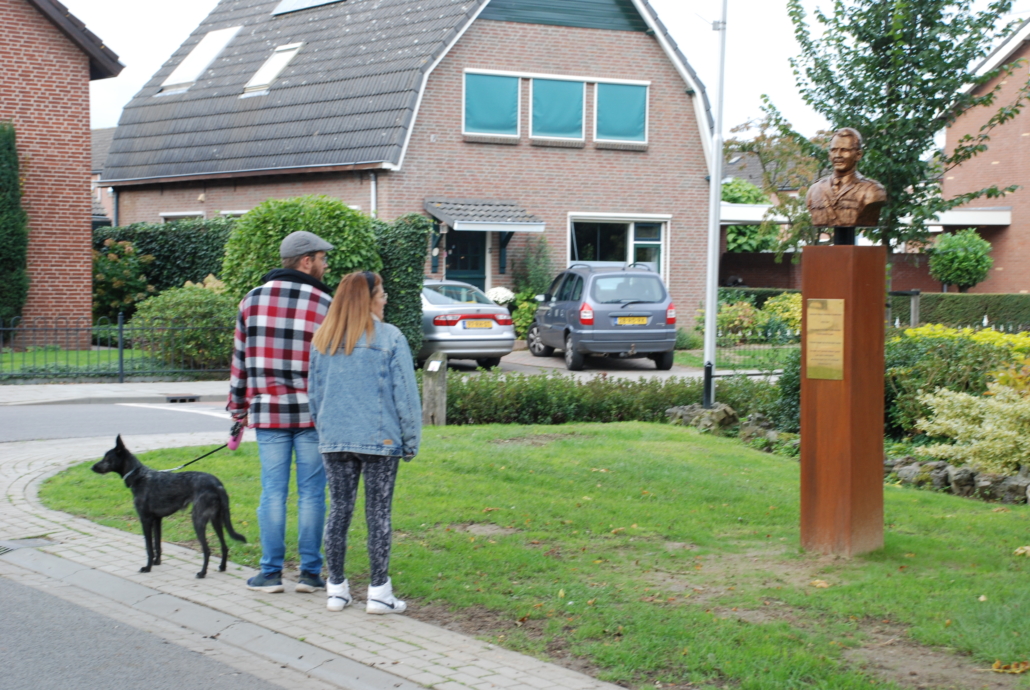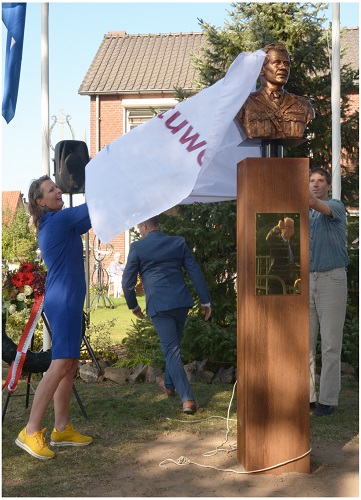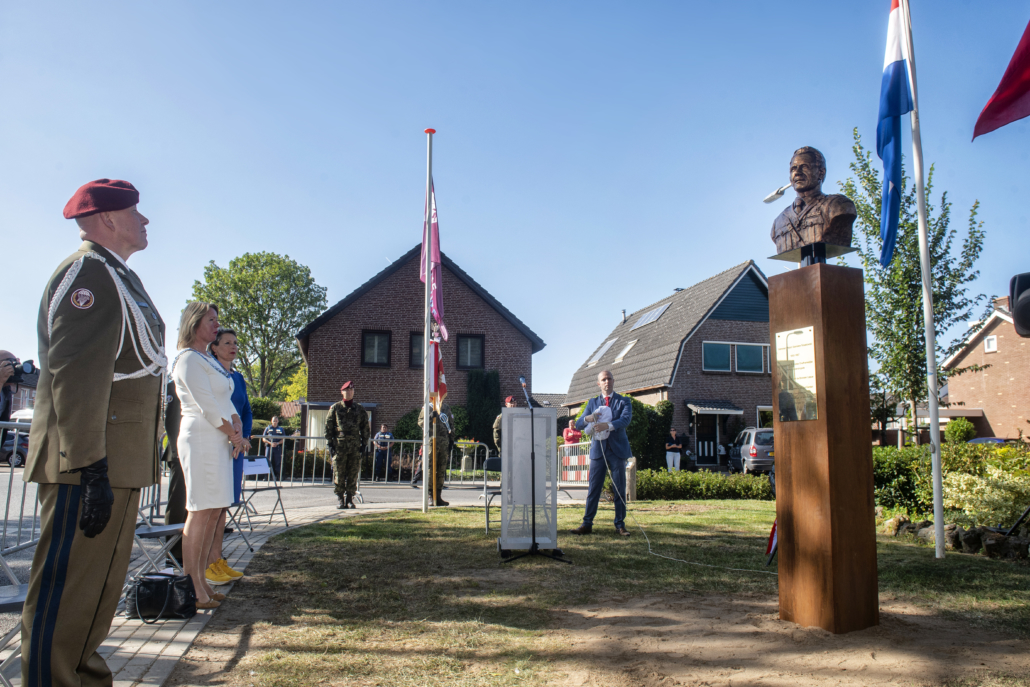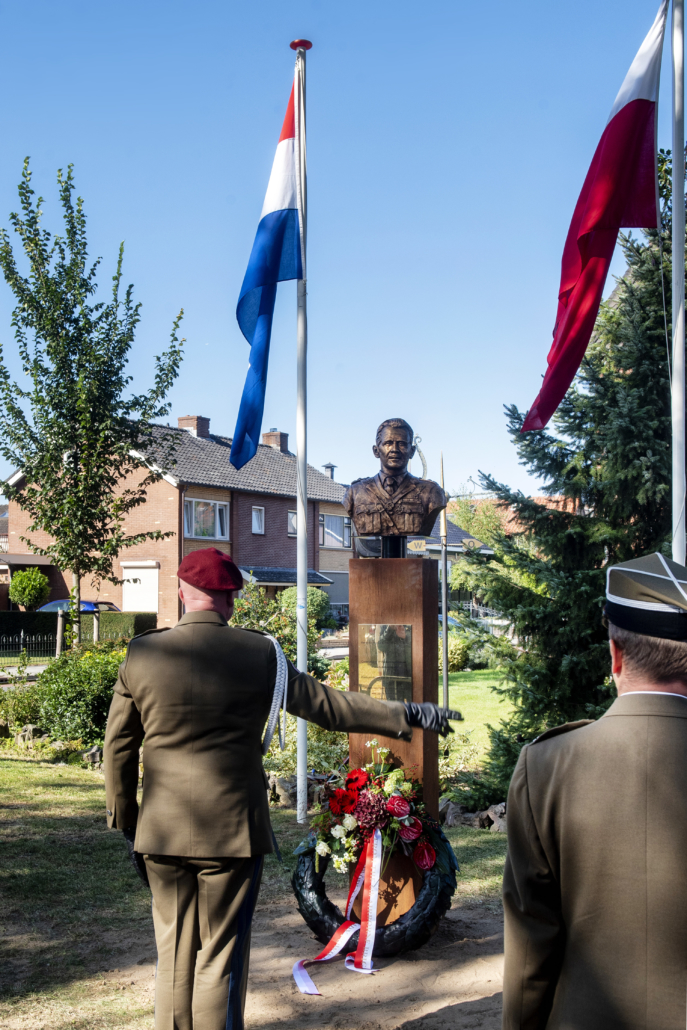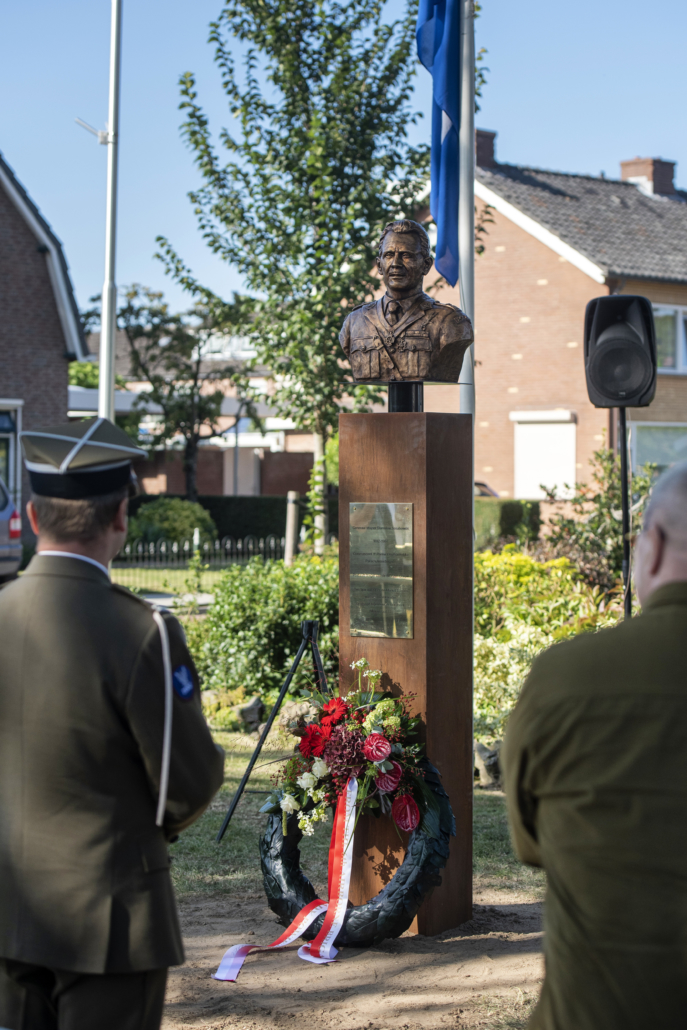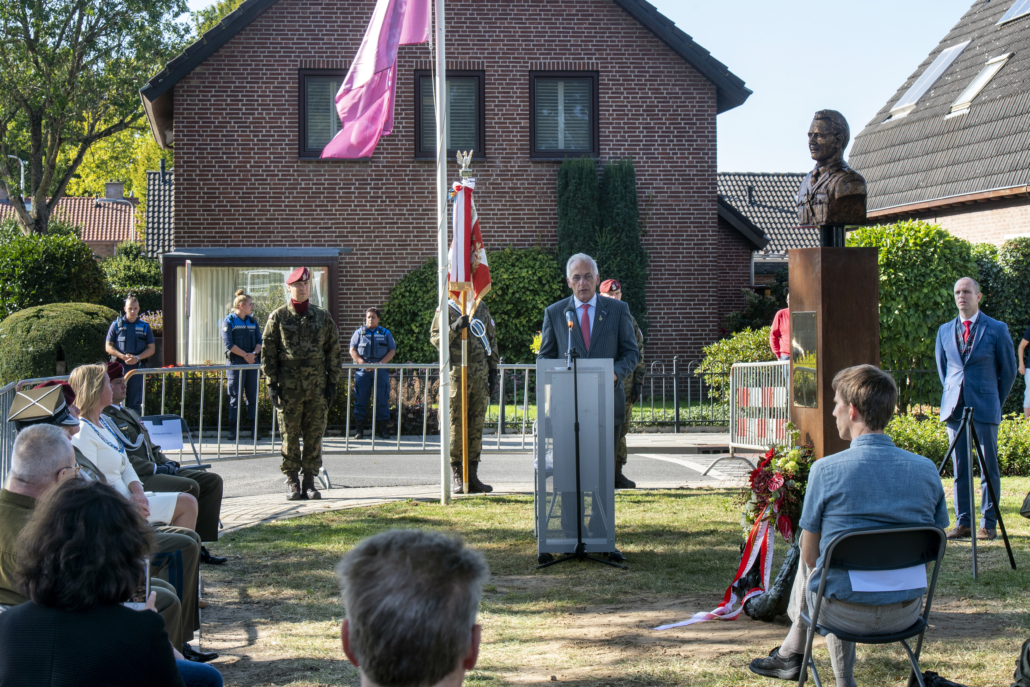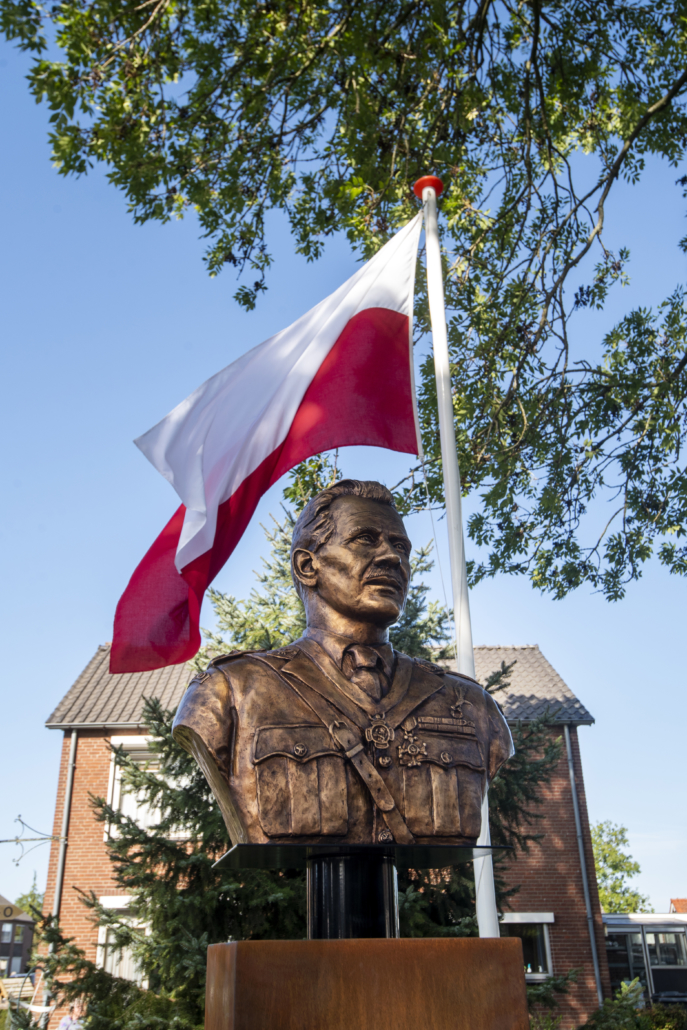Honorary President: Jennifer, Lady Gretton DCVO JP
Patron: Air Vice Marshal Ranald Munro CBE TD VR DL
Dutch Patron: Dr Robert Voskuil
Padre: The Reverend Brian McAvoy MBE MA RAF (retd)
Newsletter, November 2020
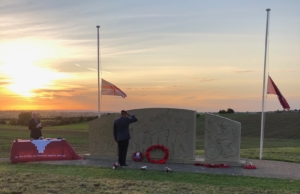
‘At the going down of the sun – we will remember them’
The 76th Anniversary of Operation Market Garden has come and gone, sadly this year our commemoration plans were torpedoed by, of all things, a virus. We are determined that the date will always be marked by a service of remembrance. So it was, on Saturday 12th September, that a small number of relatives and friends gathered at the Memorial for an ‘At the Going Down of the Sun’ service led by padre Brian McAvoy. A highlight of the service was the wonderful rendition of the Last Post and Reveille played by former Parachute Regiment bugler, Maisie Lee.
The beautiful hand knitted poppy wreath was laid by our President, Jenny Gretton. The wreath was one of two knitted last year by the ladies of Pickwell (The Pickwell Knit and Natter Group). Pickwell is the closest village to Somerby, the Battalion’s HQ in 1944. Almost simultaneously, across the North Sea, the second ‘Pickwell’ wreath was being laid at the 10th Battalion Marker in Oosterbeek – organized by our Dutch friends, Liset and Jelle Vos.
What makes this so poignant is that the Dutch wreath (which left Leicestershire last year and will not return) represents those of the Battalion who left but never returned to Leicestershire.
Liset and Jelle also led the flower children, of the De Marienborn school in Oosterbeek, to lay cards on all of the 10th Battalion graves in the Arnhem Airborne Cemetery.
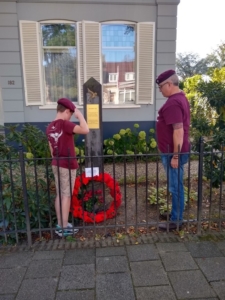
Jelle Vos and Chris Dimond pay their respects at the 10th Bn Marker, Oosterbeek
At Somerby All Saints church, a ‘Friends of The Tenth’ rose, donated by Davina and Michael Bates, was planted and dedicated by Padre Brian.
Davina was a young girl in 1944 living in the village and has many memories of those times as well as all the commemorations that have taken place since.
Davina and Michael also donated ‘Somerby Main Street’ – the original granite setts walked on by the Battalion that are now laid at various points in the Memorial Garden.
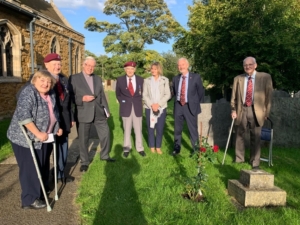
Davina, far left and Michael, far right, at the dedication of the rose
During these acts of remembrance there was a special place in our hearts and prayers for those veterans and friends whom we have lost this year. Little more than a year ago we were enthralled to welcome Freddie Deane and John Jeffries as our VIP guests at the unveiling of the Memorial.
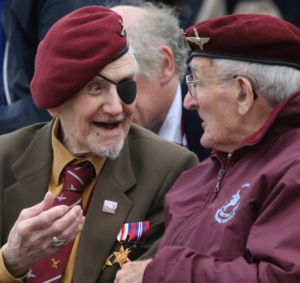
Freddie Deane and John Jeffries at the unveiling, September 2019
So, it is very sad to report that both Freddie and John have, this year, left us. The covid number restrictions placed on both their funerals meant that we were not able to be represented at John’s. But we were at Freddie’s service in North Wales and were able to pay our respects and lay a beautiful floral tribute to one of the last men of the Battalion.
The scheduled Remembrance service was also scuppered but thanks to Padre Brian we pre-recorded a service which many of our supporters and friends were able to watch at 11.00 hours on Remembrance Sunday, 8th November. This recording is still available to watch on our website, should you wish to do so; this is the link – https://friendsofthetenth.co.uk/2020-remembrance-sunday/
As far as we are aware, the ‘Last Man Standing’ and only survivor of the WW2 Battalion is the wonderful and extraordinary Victor Gregg. In October, a few of us were delighted to meet up with Vic in his new home of Goring on Thames to celebrate his 101st Birthday. Vic was in top form; a three-hour pub lunch flew by and as always, we were treated to many brilliantly told stories from his remarkable, indeed unique, life. If you have not already done so, you must read Vic’s autobiography, ’Rifleman’ (Bloomsbury Press), which is available from all the usual outlets. Recently, British astronaut, Major (AAC) Tim Peake declared ‘Rifleman’ at the top of his reading list and no wonder when you delve into Vic’s biography. Vic has always lived on his wits, from an early age as a ‘Kings Cross Kid’ through his front-line service in North Africa with the Rifle Brigade, joining the Long-Range Desert Group (forerunner of the SAS) and his eventual capture as a 10th Battalion paratrooper at Arnhem. His POW death sentence handed out for sabotaging a German soap factory and astonishing release due to the Allied air raids on Dresden. His post-war exploits as a communist trade union convener and something of a double agent whilst working for the Russians and MI5. As I say – you must read this book which reinforces that old adage of ‘truth being stranger than fiction’. I’m sure that before too long ‘Rifleman’ will be produced as a blockbuster film!
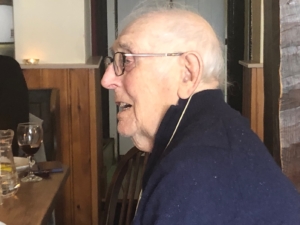
It seems scarcely believable that Vic is now into his second century!
Our project to deliver an ‘Arnhem in Leicestershire’ heritage trail, with plaques indicating properties of historical significance in and around Somerby, is moving ahead nicely. Jane and Neil Thorley, owners of the Vines in Thorpe Satchville have recently installed their plaque, and more are in production, including our President’s home, Somerby House which was Battalion HQ, also the Somerby Sergeant’s mess and Somerby Grove (‘A’ Company).
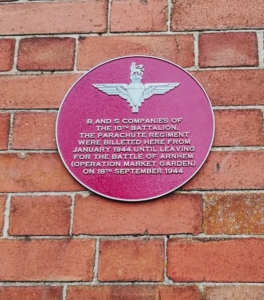
Plaque installed at the Vines, Thorpe Satchville
Just as in 1943-44, we look forward to seeing lots of regimental maroon in East Leicestershire!
To whet your appetite, we hope to soon announce another major and the most exciting initiative since the unveiling of our Memorial – watch this space but this is for another day!
For now, I am delighted that, once again, our supporters have come up trumps with a number of guest articles. The following is by Prosper Keating. Prosper is a published author and journalist, he served in 10 Para V. More ‘guest’ articles will follow in subsequent issues.
DESERT BREEZE – PART ONE
The new Orders for 2nd Battalion, The Royal Sussex Regiment, were posted on New Year’s Day, 1943. The Orders stated: ‘Lt. Col. K.B.I. Smyth relinquishes command of 2 Bn Royal Sussex and assumes command of this Bn. All volunteers of Royal Sussex, numbering 7 officers, 5 WO’s, 4 C/Sgts, 24 Cpls and 104 other ranks are transferred to this Bn. The Bn will then form on these figures, all stores and equipment are taken over from 2 R. Sussex. 65 men have already qualified as parachutists and a further 80 are on a course. Courses are organised by 4 Middle East Training School, Kabrit.’.
A typical British infantry battalion of the era numbered some 850 officers and other ranks. The Royal Sussex had had a hard time of it lately at the battle of Alam el Halfa, where they faced Rommel’s Panzers, and El Alamein. They were in hand-to-hand fighting with the very tough paratroopers of the Italian Folgore Division.
The lads who’d chosen to stay, when the Battalion’s conversion to Parachute status was announced after the victory at Alamein the previous November, had been joined by volunteers from the Sussex Regiment’s 4th and 5th Battalions.
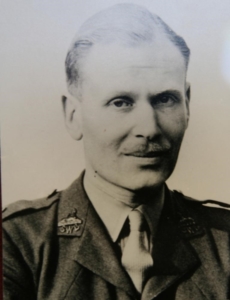
Posted to the Royal Army Service Corps Base Depot at Geneifa, some twenty miles north of the port of Suez on the Suez-Ismailia highway, they were joined by men from other regiments and corps. As a holding and dispersal centre for soldiers whose units had been wiped out or who were almost recovered from wounds, Geneifa was an ideal location for staff officer Ken Smyth, late of the South Wales Borderers, who had been charged with forming a new parachute battalion as part of the move to enlarge British Airborne Forces before the coming battles on the European continent.
For the time being, 2 RSR’s new name was S Battalion, the S standing for Sussex. Geneifa was a tented base around a hub of brick and wooden buildings housing the administration offices, medical centres, various canteens and the camp cinema. There were latrine blocks although most of the lads preferred the open-air arrangements consisting of benches over septic tanks because the wind took the stench away. Every couple of days, the latrine detail would tip a couple of jerry cans of petrol down the holes and toss in a burning rag. Every so often, some fool would end up with nasty ‘posterior’ burns because he had not seen the red pennant.
One of the better canteens was Dunbarton House, run by the Free Church of Scotland. The tea, buns and lemonade were the best in Geneifa, and the Minister and his helpers didn’t badger the lads about God and salvation. The beer in the NAAFI wasn’t much good but it was better than nothing. Mindful of Nelson’s adage about men and ships rotting in harbour, Colonel Smyth kept the lads occupied with regular field training as well as the usual garrison duties like ‘bulling’ and ‘blancoing’ personal kit and billets.
After twenty-mile route marches in battle order into the jebel to the west of Geneifa, the lads would dig in, which was no easy task on the rocky desert crust. They might spend two days in their two-man fire trenches scanning the horizons for an enemy who was actually in full flight towards Tunisia in January 1943. The NCOs might come around and order them to move position to a grid reference a mile away, which meant filling in the holes, moving to the new location and digging new holes. If they were lucky, they’d march the twenty miles back to camp in the chill of the night, when a man in the desert was grateful for any way of warming himself up. Cold as it was, it was still easier than marching under the sun.
Hygiene was strictly enforced with regular inspections of mess tins and eating utensils, which had to be cleaner than new at all times except when you were using them. Water bottles were inspected, and you were on a charge if the contents didn’t smell of the Halazone purifying tablets you were issued every day. Any of the old hands who’d served in India and Palestine could tell you that trusting the water, even from the camp bowsers or the natives’ wells, was a mug’s game.
Useful Arab words included ‘moya’, which meant water. The natives, who were Egyptians rather than Arabs, happily offered you water when you stopped near their homes and wouldn’t accept any money for it but filling up your water bottle from their personal supply was bad manners. Taking an earthenware mugful was the done thing but they’d let you fill your water bottles from their wells, as long as you asked first. They were sticklers for good manners.
Any desert soldier worth his salt learned to fill his water bottle at any opportunity. Any puddle, no matter how much goat piss it contained, was good enough as long as you used your Halazone tablets. And then there was recycling your water, but you didn’t mention that in the postcards home – not that the Army Censor would have passed it anyway.
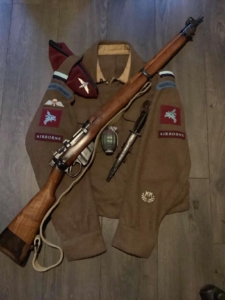
Another Arab word you heard a lot was ‘gareeb’, which means nearby or, at any rate, not far away. Desert people don’t think in miles when they travel. They think in days. A day’s camel ride was not far for a Son of the Desert, but it was a bloody long way for an infantryman in full kit. If the native was on a donkey, which is slower than a camel, ‘gareeb’ might not mean as many miles. All of that considered, anywhere by foot in the desert is far away for men raised in Sussex fields or London boroughs. And like the Celts of our islands, Arabs dislike telling travellers that they have a long way to go, it is considered bad manners. So, everywhere is gareeb.
There was a beach reserved for servicemen a couple of miles to the north on the shore of the Great Bitter Lake, which lived up to its name if you got a mouthful of it. But it wasn’t poisonous like the River Nile. If you fell in the Nile, it was straight off to an army hospital where the medics stuck more needles in you than a pin cushion. The Nile was as filthy as Old Man Thames. The natives were immune to it and so were the Battalion’s Londoners who’d grown up swimming in the Thames. They didn’t often suffer from ‘Delhi belly’. Nor did the old hands who’d served with the Royal Sussex in Karachi in the early ‘Thirties or in Palestine a few years later.
The lake had been formed when the Suez Canal was built, providing anchorages for ships in transit. The lads of S Battalion who were waiting to do their parachute courses at RAF Kabrit could see the aircraft taking off from the airfield a mile to the east of the swimming beach and climbing to 800 or 1,000 feet before making their runs over the drop zone on the flatlands across the lake. The aircraft were mostly converted Wellington bombers but sometimes they saw Lockheed Hudsons or Douglas Dakotas dropping their comrades.
Sometimes they caught a whiff of aviation fuel on the breezes wafting across the water from the airfield, built on a promontory where the lake narrows into the southern part of the canal. They counted the seconds off after the parachutes deployed. It usually took around forty seconds for a man to reach the ground but if a rising thermal caught his canopy, it could take twice that time or longer. They’d bet a bob or two on it, which made a change from betting on beetle races or how far they could piss against the desert wind. And they thought of their imminent appointment with the Parachute Jump Instructors of N°4 Middle East Training School.
N°4 METS had evolved in the year since ‘Gentleman Jim’ Almonds and his fellow Special Air Service NCOs had built the first rudimentary parachute training facilities at RAF Kabrit with four PJIs sent by the RAF. Almonds’ diary noted on October 6th, 1941: “Afternoon spent jumping backwards from a lorry at twenty-five miles per hour. Three broken arms and a number of other casualties. Broken bones through training now six.”. Jumping from moving lorries, although brutally effective as a preparation for military parachuting, was a thing of the past at RAF Kabrit when the lads of S Battalion passed though.
RAF Kabrit was a couple of miles by road from Geneifa, but the RAF laid on transport at the beginning and end of each day in the form of Bedford QL lorries. The latest thirty-man course intake paraded at 0700hrs in front of the S Battalion office. They shivered in the cold as Colonel Smith addressed them. The Battalion was counting on them. The old regiment was chasing Rommel and his Italian friends through Libya with the rest of the Eighth Army – but they were not to fret as they would be seeing the Hun again soon enough.
The Regimental Sergeant Major stepped forward, banging his right foot down as he came to attention, his pace stick under his left arm. “Platoon! Platoon, Shun! Officer on Parade, Dismiss!” Turning smartly to the left and banging their right feet in as if they were on parade at Buckingham Palace, the platoon saluted and off three paces before breaking ranks and running to the waiting lorries. Ken Smyth watched them: “They look keen, RSM.”. The RSM nodded: “They’re good lads, sir. They won’t show us up over there. All good lads!”.
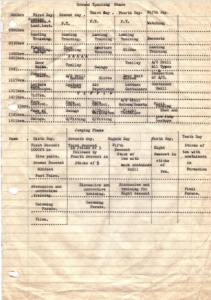
The lads were silent as the lorries rumbled along the road towards Kabrit. Some wondered anxiously if they would refuse in the door. But it was an idle fear because the fear of shaming yourself in front of your mates – and shaming them too – overcame any fear of parachuting in all but the rarest of cases. Others wondered if they would ‘candle in’, as plunging to your death because of a parachute malfunction was known. But if death came to them that way, it just meant that their number was up, that’s all.
At 0750 hrs, the platoon was standing at ease in three ranks in front of the N° 4 METS Orderly Room. A staff-sergeant wearing the Physical Training Corps cap badge on his side hat marched up and came to attention in front of them with a clipboard under his arm. “Platoon, Platoon, Shun! Stand at ease!”. Taking a pencil from the pocket of his sharply pressed shirt, he spoke again: “I am Staff Sergeant Meane. I am your PT instructor and I am also an Assistant Parachute Jump Instructor. Right, listen up for your names. You come to attention and you answer ‘Yes, Staff’, which tells me that you are here and that you are alive. Afterwards, I shall hand you over to the Royal Air Force. Right! Off we go, then!”.
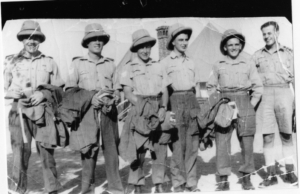
Assistant Parachute Jump Instructors from the Army in Kabrit in 1942.
Note -the parachute wings above the righthand pockets of their shirts and the parachutist pattern trousers
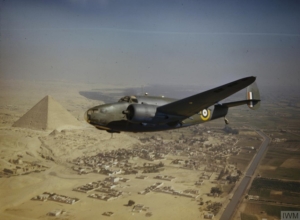
An RAF Lockheed Hudson over Cairo in 1943
N° 4 METS sometimes used Hudsons for parachute training
(Imperial War Museum)
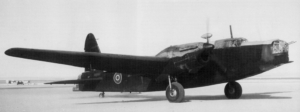
One of the Wellington bombers used for parachute training by N° 4 METS at RAF Kabrit in 1942 and 1943
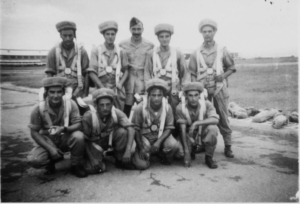
Trainee Parachutists with their RAF PJI. They are wearing the canvas-covered sorbo rubber training helmets and Irvin X-Type parachutes in shirtsleeve order
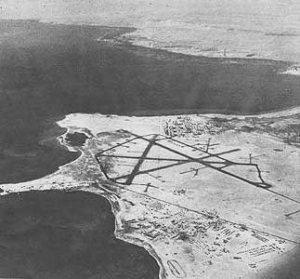
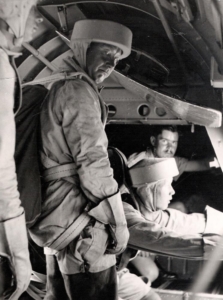
Trainee parachutists in a Lockheed Hudson over RAF Kabrit in 1943. They wear the canvas- covered sorbo rubber helmets and early step-in over-smocks modelled on the German ‘bonesack’ smocks
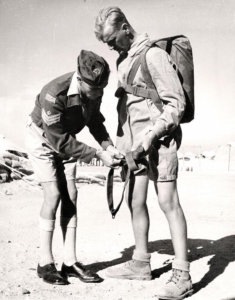
An RAF PJI shows a trainee parachutist – probably from the SAS – how to put on the Irvin X-Type parachute at RAF Kabrit
Prosper Keating for FOTT, September 2020
FOTT Film Productions
We will have the following films in our website shop. They are available as either a download, DVD or USB memory stick. Follow this link to order https://friendsofthetenth.co.uk/shop/
Remembering The Tenth
The hour-long film tells the story of the Memorial, the unveiling and includes an exclusive and riveting interview with 10th Bn Veteran, Victor Gregg, as well as a memorable introduction by Pam Henry-Lamm, the widow of Captain Myles Henry KIA. It includes IWM footage from Market Garden. Brilliantly and professionally made and directed by Thomas Hallifax and his fellow students at Brooksby-Melton Media College. A must see of that very special day last September.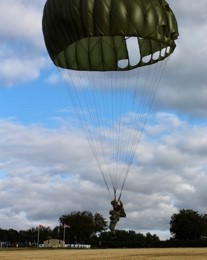
Albert Willingham: Hero from England
This beautiful, poignant, short film was professionally made in the Netherlands and features Dr Robert Voskuil and Jelle Vos (our Dutch mascot and poster boy) with some of his school friends, telling the story of the infamous cellar at number 2 Annastraat and Albert’s ultimate sacrifice. A perfect film to gently introduce children to the history.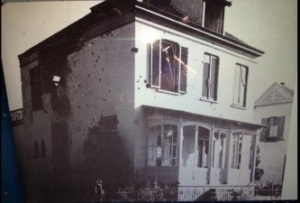
The 70th Somerby Commemoration
An hour-long film made in 2014 which follows the weekend in Somerby and the presentation of the Somerby Cockerel to the Bishop of Leicester (on behalf of All Saints, Somerby) by 10th Bn Veteran, Gerry Dimmock.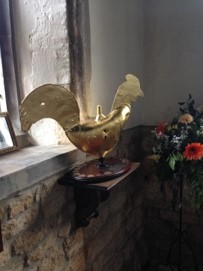
The unveiling photo album
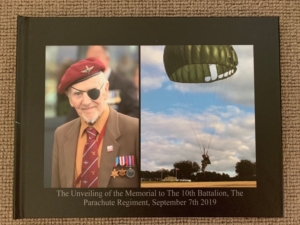
In our website shop is the photo album of the unveiling last September. This A4 high quality, hard cover, book has 58 pages of more than 150 colour images by our brilliant photographer, Arjan Vrieze. It comes in a presentation box. A lovely memento of an amazing day. Follow this link to buy a copy – https://friendsofthetenth.co.uk/product/remembering-the-tenth/
I quote our President – Jennifer, Lady Gretton;
“The most wonderful memento of a memorable day has just arrived! I think it is done most beautifully with some lovely photos and what a wonderful reminder of a very special occasion. All the heartache and worry during the preparation came to a wonderful conclusion on the 7thSeptember.
This will bring back so many happy memories for so many people and I know that everyone will say that it has certainly been worth waiting for!”
The Last Stand of The Tenth
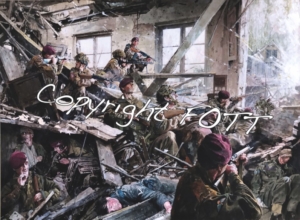
Those of you who do not have a print of Derek Chamber’s ‘The Last Stand’ may want to buy one. We have 3 versions for sale in our website shop. Please see ‘Merchandise’ below.
MERCHANDISE
Please visit our website shop where we have for sale, Christmas cards, T shirts, ties and bowties, badges and prints.
Also of course, the films and photo album featured above.
To buy, visit – https://friendsofthetenth.co.uk/shop/
The Somerby Cockerel is a limited edition (75) hand-made, gold-plated and hall-marked, solid sterling silver pin badge.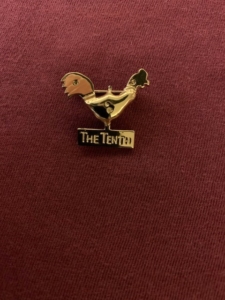
We also have the ‘Unveiling Package’ for sale at only £10 which includes the souvenir brochure, order of service, two badges and windscreen sticker (total value £18!).
THE FRIENDS OF THE TENTH ROSE
This rose was propagated to remember the Boys of The Tenth. It is the same as those that have been planted in the Memorial Garden and at All Saints church, Somerby. C & K Jones make a donation to us for each rose sold.
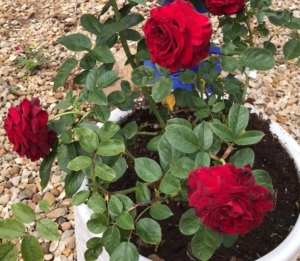
It is available to buy from:

01829 740663 ck.jones@jonestherose.co.uk
Past & present NEWSLETTERS
Thanks to our great supporters at Reach Marketing, we have a new facility on our website. You can now read, in book ‘turning page’ format, this and previous newsletters.
Follow this link – https://friendsofthetenth.co.uk/newsletters/
REQUESTS
PLEASE? If you know anyone who does not ‘do’ emails and you think would like a copy of this newsletter, would you kindly print a hard copy and forward or post it to them?
Alternatively, contact me and I will post a hard copy to anyone unable to download this.
Should anyone wish to help in any way whatsoever, I would be delighted to speak with you. There is much more information on our website and social media pages:
www.friendsofthetenth.co.uk
https://www.facebook.com/groups/friendsofthetenth/
An easy way to access our website is to use your mobile phone to scan this barcode

If anyone would like to contribute to this magazine, I will be delighted to hear from you. Any material must be relevant to the WW2 10th Battalion or our current work to keep the legacy of the Battalion alive. We also reserve editorial rights.
You can contact me at:
alec@friendsofthetenth.co.uk
Alec Wilson
November 2020
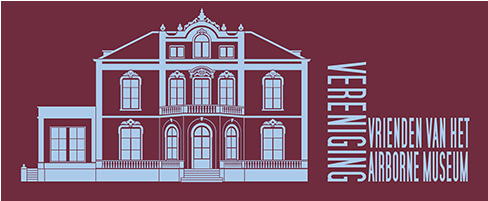
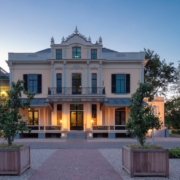
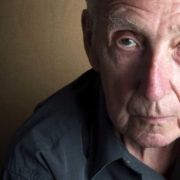 ANP/HH
ANP/HH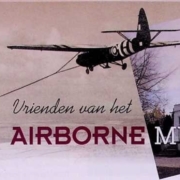
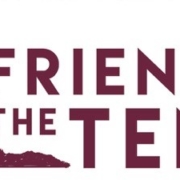




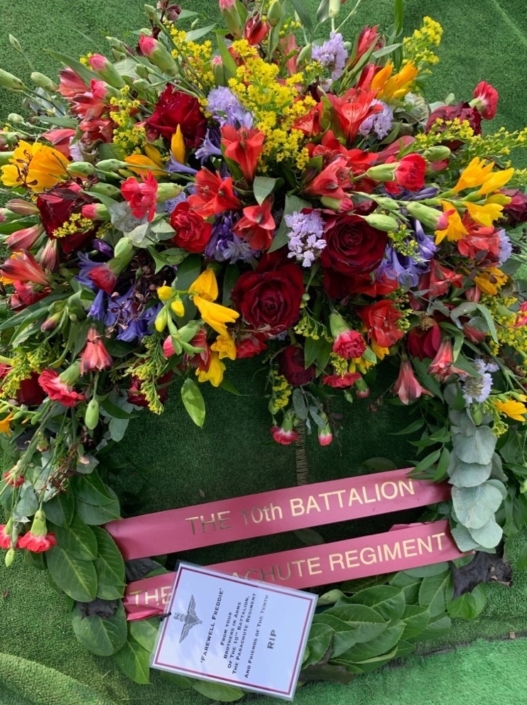
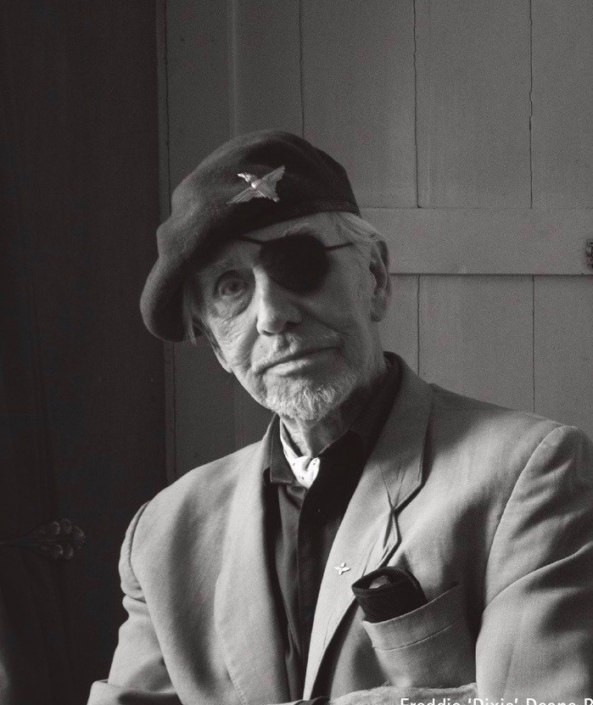





















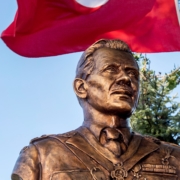 Gerard Burgers
Gerard Burgers